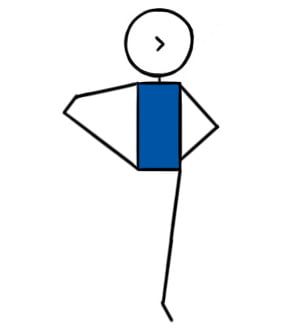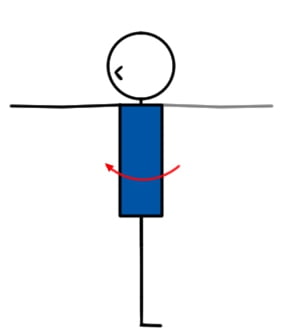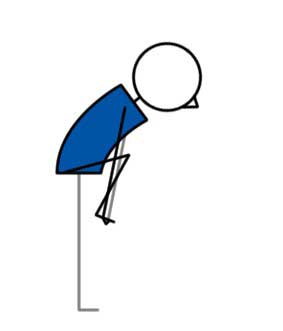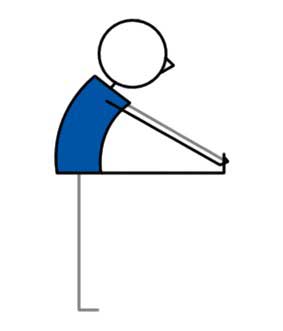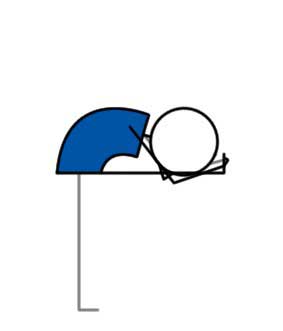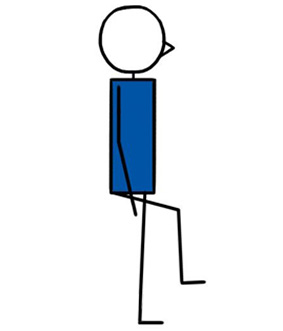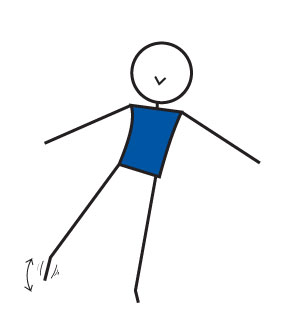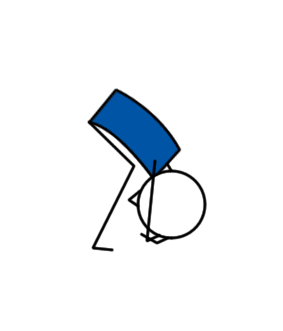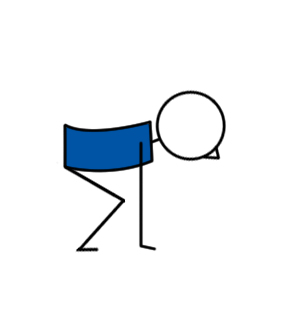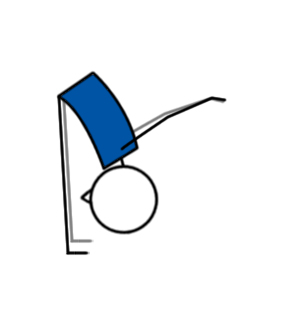
One Leg Revolved Mountain
| Sanskrit Name: | Eka Pada Parivrtta Tadasana |
|---|---|
| Similar Pose Names: | One Legged Revolved Mountain |
| Category: | Standing |
| Share on: |
 Yoga Lesson Planner
Yoga Lesson Planner
 Pilates Lesson Planner
Pilates Lesson Planner
| Category: | Yoga Lesson Planner |
|---|---|
| Sub Category: | Standing |
| Types: | Balance, Hip Opener, Standing, Strengthen, Stretch, Twist |
| Anatomy: | Core, Hamstrings, Hips, Lower Back, Psoas |
| Chakras: | Base, Sacral Centre, Solar Plexus Centre |
| Therapy: | Leg Congestion, Sciatica, Varicose Veins |
| Drishti: | Tip Of Nose |
| Dosha: | Kapha, Pitta |
Stand in Mountain Pose with feet hip-width apart. Arms extended at shoulder level in a ‘T’. Inhale, bend right knee to hip level, keeping the foot flexed and active. Exhale, twist torso to the right and hold. To release, exhale, untwist, lower the leg, and return to the start position. Repeat on left side.
Strengthens thighs, calves, ankles, spine.
A) Back against a wall. B) Close eyes. C) Bring hands overhead. D) Hands on hips.
Knee injury.
Click here for lots of FREE downloadable Yoga lesson plans.
Click here for lots of FREE downloadable Pilates lesson plans.
- Monday P
- 239, zoom M
- August 2024 - Intermediate Sthira & Sukham- steadiness & ease - Element Air, Annahata Chakra, Meridian Line Lung
- Core Aug 2024
- Yoga for Greenland Rolling
- October 24 Intermediate Water Element, Bladder Meridian Line, Svadhistana Chakra
- Mogias Lesson Plan
- Ask Genie 3
- Feb 2025
- Hatha Yoga - lezione 23
- 24, zoom M
- 240, zoom M
- Y2 W4
- 241, zoom M
- Y2 W5
- 23, Greenwood Park
- 242, Zoom M
- New Beginnings week 3
- 245, Zoom M
- Ask Genie 1
- Sun Goddess
- Sun Goddess wk 14 2025
- 28 April 2025
Yoga Lesson Plan: Twist Theme with One-Legged Revolved Mountain Pose (Eka Pada Parivrtta Tadasana)
Objective: Enhance spinal mobility, improve balance, and strengthen the core with a focus on twisting poses, culminating in One-Legged Revolved Mountain Pose as the peak pose.
Duration: 60 minutes
Warm-Up (10 minutes)
Begin the class in Child’s Pose (Balasana), encouraging deep breathing and intention setting. Move into Cat-Cow Pose (Marjaryasana-Bitilasana) to warm up the spine with gentle flexion and extension. Transition into Downward-Facing Dog (Adho Mukha Svanasana) to stretch the hamstrings, calves, and shoulders, then ease into Standing Forward Bend (Uttanasana) to relax the neck and spine, gently stretching the back of the body.
Standing Sequence (20 minutes)
Start in Mountain Pose (Tadasana) to ground through the feet, find balance, and connect with the breath. Move into Warrior I (Virabhadrasana I) to strengthen the legs, open the hips, and stretch the chest. Follow with Warrior II (Virabhadrasana II) to engage the core, strengthen legs, and improve focus. Transition to Extended Side Angle Pose (Utthita Parsvakonasana) to deepen the stretch in the side body and hips, then move into Triangle Pose (Trikonasana) to lengthen the spine, open the chest, and stretch the hamstrings. Finish this sequence with Chair Pose (Utkatasana) to strengthen the thighs, glutes, and core.
Twisting Sequence (20 minutes)
Begin with Revolved Chair Pose (Parivrtta Utkatasana) to introduce the twisting motion, engaging the core and promoting spinal mobility. Move into Revolved Crescent Lunge (Parivrtta Anjaneyasana) to deepen the twist and strengthen the legs, followed by Revolved Triangle Pose (Parivrtta Trikonasana) to further enhance the spinal twist and stretch the hamstrings. Practice Half Lord of the Fishes Pose (Ardha Matsyendrasana) for a seated twist that stretches the spine and shoulders.
Peak Pose Preparation (10 minutes)
Practice Tree Pose (Vrksasana) to improve balance and stability. Follow with Standing Figure Four Pose to open the hips and enhance balance. Move into a modified version of the peak pose with Wall Support: Stand near a wall and use it for support to maintain balance while twisting. This prepares the body for the final pose.
Peak Pose: One Legged Revolved Mountain Pose (5 minutes)
Demonstrate and explain Eka Pada Parivrtta Tadasana, showing the full pose and explaining key alignment points. Guide students into the pose on each side, emphasizing balance, twist, and breath. Offer modifications such as holding the ankle, using wall support, or performing a gentler twist.
Cool Down (10 minutes)
Start with Seated Forward Bend (Paschimottanasana) to calm the mind and stretch the back of the body. Follow with a Supine Twist (Supta Matsyendrasana) to release the spine and relax the body. Move into Happy Baby Pose (Ananda Balasana) to open the hips and lower back, and finish with Corpse Pose (Savasana) for complete relaxation, integrating the benefits of the practice.
Conclusion (5 minutes)
Conclude the class with a short seated meditation, focusing on breath and inner calm. Offer closing remarks and Namaste to reflect on the practice and express gratitude.
Throughout the class, emphasise the importance of breath and offer modifications and props for students with varying levels of flexibility and balance. Encourage students to listen to their bodies and avoid pushing into pain. This lesson plan ensures a well-rounded practice, preparing the body for the peak pose, Eka Pada Parivrtta Tadasana, while promoting overall strength, flexibility, and mental focus.
If you want to include modifications within the lesson plan, take a look at these ones…
11 Modifications for One Leg Revolved Mountain Pose
Modification 1: Ankle Hold
Hold the ankle with one hand and use the other hand to balance.
Modification 2: Wall Support
Stand near a wall and use it to support and maintain balance while twisting.
Modification 3: Chair Support
Place a chair beside you and hold the backrest for extra stability.
Modification 4: Bent Elbows
Keep elbows bent instead of extending arms fully to reduce strain on shoulders.
Modification 5: Foot on Block
Place the lifted foot on a yoga block for additional support and stability.
Modification 6: Gentle Twist
Perform a gentler twist by turning the torso only partially to reduce intensity.
Modification 7: Lower Leg Lift
Lift the knee to a lower height, such as mid-thigh, for easier balance.
Modification 8: Arm on Hip
Keep one hand on the hip for better balance while the other arm twists.
Modification 9: Seated Version
Sit on a chair, lift one knee, and twist the torso to the side.
Modification 10: Strap Assistance
Use a yoga strap around the foot of the lifted leg for better control and balance.
Modification 11: Core Engagement
Focus on engaging the core muscles more to help with balance and stability.
Your yoga students will want to know why balance poses are so good for them, so let them know a few of the benefits.
5 Benefits Of Balance Poses
Balance is the ability to control one’s body’s position, whether stationary (e.g., in a complex yoga pose) or while moving (e.g., playing golf). Balance is a key component of Yoga, along with strength and flexibility poses.
Benefit 1: Body Awareness
Body awareness is how your limbs are oriented in space, also known as proprioception. Balance training improves body awareness, which decreases the likelihood of injury.
Benefit 2: Coordination
Balance poses require your entire body to work harmoniously; otherwise, you will fall or stumble. Improved coordination during balance poses will be transferred into coordination in everyday life.
Benefit 3: Joint Stability
Balance poses help promote stable knees, ankles, hips, and shoulders, preventing many injuries, including sprained ankles and knee problems.
Benefit 4: Reaction Time
Balance poses can improve your reaction time. If you slip or stumble while performing balance poses, your body needs to rebalance immediately, or you will fall. This, in turn, will improve your reaction time in everyday life.
Benefit 5: Long-Term Health
Adding balance poses into your Yoga session helps to maintain or improve your balance, which is needed to prevent falls and fractures. As we age, our balance can deteriorate. Yoga balances will help delay that deterioration.
Your yoga students will want to know why twist poses are so good for them, so let them know a few of the benefits.
5 Benefits Of Twists
Yoga twists are powerful poses that involve rotating the spine and torso, offering numerous physical and mental benefits. These movements help improve spinal mobility, aid digestion, detoxify the body, reduce stress, and enhance overall posture.
Benefit 1: Improved Spinal Mobility
Twists help increase the range of motion in the spine, promoting flexibility and reducing stiffness.
Benefit 2: Enhanced Digestion
Twisting poses massage the abdominal organs, improving digestion and alleviating bloating.
Benefit 3: Detoxification
Twists help stimulate the internal organs, aiding in detoxification by promoting circulation and removing toxins.
Benefit 4: Stress Relief
Twists can reduce stress and promote relaxation by opening the chest and releasing tension in the back and shoulders.
Benefit 5: Better Posture
Regular practice of twists can strengthen the muscles around the spine, encouraging better posture and alignment.







